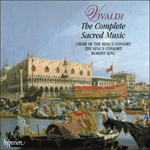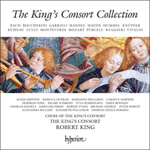
Welcome to Hyperion Records, a British classical label devoted to presenting high-quality recordings of music of all styles and from all periods from the twelfth century to the twenty-first.
Hyperion offers both CDs, and downloads in a number of formats. The site is also available in several languages.
Please use the dropdown buttons to set your preferred options, or use the checkbox to accept the defaults.

Each coro in Ruggieri’s Gloria comprises soprano, alto, tenor and bass voices and strings in five parts (dividing the violas). Coro I has in addition two oboes, coro II a trumpet and an oboe. Soloists are extracted as needed. The variety of scoring among the individual movements is quite extraordinary. For example, in the fifth movement, ‘Domine Deus, rex coelestis’, each coro features a string component made up of two violas and cello and a vocal component made up of two sopranos and bass. The next movement, ‘Domine Fili unigenite’, is a three-way conversation between solo alto, two violins and two oboes.
Ruggieri is certainly one of those innumerable forgotten composers who is ‘worth hearing more of’. This Gloria is of interest and value not only for its obvious influence on Vivaldi and exemplification of the Venetian polychoral tradition but also for its intrinsic musical merit and remarkable originality.
And so we reach the end of our road. This is far from being the first ‘collected recorded edition’ of sacred music by Vivaldi – it has been preceded by ones from Vittorio Negri and Michel Corboz – but it is the first to apply (if one may be permitted so grandiloquent a phrase) ‘historically informed’ criteria, leavened, as always, by the imperative to communicate effectively with a modern audience. That there will be more music in the same category by Vivaldi to rediscover and perform in the future seems guaranteed. While this text was being written, I got wind of the mention, in an eighteenth-century catalogue, of a hitherto unknown Salve regina in E minor for solo alto by Vivaldi, already baptized ‘RV804’, that employs two transverse flutes as well as the usual strings and is therefore presumably a late work. All we now need is to find the music answering to that description – and we know from the case of RV803 that the source will not necessarily be so co-operative as to include ‘Vivaldi’ in its title!
from notes by Michael Talbot © 2004
Tous les cori du Gloria de Ruggieri comprennent les voix de soprano, alto, ténor et basse et les cordes en cinq parties (divisant les violes). Le Coro I comporte en outre deux hautbois, le coro II une trompette et un hautbois. Les solistes entrent en scène lorsqu’ils sont nécessaires. La diversité de l’écriture dans les différents mouvements est assez extraordinaire. Dans le cinquième mouvement, par exemple, Domine Deus, rex coelestis, chaque coro fait intervenir deux violes et un violoncelle aux instruments et deux sopranos et une basse aux voix. Le mouvement suivant, Domine Fili unigenite, est une conversation à trois sens entre l’alto solo, deux violons et deux hautbois.
Ruggieri fait très certainement partie de l’un de ces innombrables compositeurs oubliés qui mérite qu’on l’écoute plus souvent. Ce Gloria présente un intérêt et une valeur, non seulement en tant qu’influence évidente sur Vivaldi et illustration de la tradition polychorale vénitienne, mais aussi pour son mérite musical pur et sa remarquable originalité.
Ainsi, nous arrivons au bout de notre chemin. Cette collection est loin d’être la première des œuvres sacrées de Vivaldi (elle est précédée par celles de Vittorio Negri et de Michel Corboz) mais elle est la première à appliquer (pardonnez cette phrase grandiloquente) des critères « informés sur le plan historique », relevés, comme toujours par l’impératif de communiquer efficacement avec le public actuel. De nombreuses autres œuvres de la même catégorie et écrites par Vivaldi seront redécouvertes et interprétées à l’avenir, cela ne fait aucun doute. Alors que j’écrivais ce texte, j’ai appris qu’un catalogue du dix-huitième siècle mentionne un Salve regina de Vivaldi en mi mineur encore inconnu. Œuvre pour alto solo, il serait déjà baptisé « RV804 » et mettrait en scène deux flûtes traversières et les cordes habituelles. Il constitue très probablement une œuvre plus tardive. Maintenant, il nous faut trouver la musique qui répond à cette description. Et nous savons, grâce à l’affaire RV803, que nous pouvons nous attendre à une source peu coopérative : elle risque de ne pas même mentionner le nom de Vivaldi en titre !
extrait des notes rédigées par Michael Talbot © 2004
Français: Marie Luccheta
Die beiden cori des Gloria von Ruggieri bestehen jeweils aus Sopran-, Alt-, Tenor- und Bassstimmen sowie einem fünfstimmigen Streicherkorpus (die Violen sind geteilt). Coro I hat zusätzlich zwei Oboen und Coro II eine Trompete und eine Oboe. Die Solisten werden nach Bedarf eingesetzt. Es ist recht außergewöhnlich, wie verschiedenartig die einzelnen Sätze angelegt sind. So bestehen etwa im fünften Satz, „Domine Deus, rex coelestis“, beide cori jeweils aus einer Streichergruppe, die sich aus jeweils zwei Violen und Cello zusammensetzen, und einer Sängergruppe mit jeweils zwei Sopranstimmen und einem Bass. Der folgende Satz, „Domine Fili unigenite“, ist eine Dreier-Unterhaltung zwischen Solo-Alt, zwei Violinen und zwei Oboen.
Ruggieri ist sicherlich einer jener zahllosen in Vergessenheit geratenen Komponisten, der es durchaus verdienen würde, mehr gespielt zu werden. Dieses Gloria ist nicht nur aufgrund seines offensichtlichen Einflusses auf Vivaldi und seiner Exemplifizierung der mehrchörigen Tradition Venedigs von besonderem Wert und Interesse, sondern auch aufgrund seines immanent musikalischen Verdienstes und seiner bemerkenswerten Originalität.
Und damit sind wir am Ende unseres Weges angekommen. Es ist dies zwar nicht die erste „Gesamtaufnahme“ der geistlichen Musik Vivaldis – es existieren bereits entsprechende Aufnahmen von Vittorio Negri und Michel Corboz – jedoch ist dies die erste Aufnahme, die (wenn man sich etwas hochtrabend ausdrücken darf) unter den Prämissen der historischen Aufführungspraxis entstanden ist und die dabei, wie immer, durch das dringende Bedürfnis, mit einem modernen Publikum auf sinnvolle Weise zu kommunizieren, aufgelockert wurde. Man kann fast davon ausgehen, dass auch in Zukunft noch Werke Vivaldis aus derselben Kategorie wiederentdeckt und aufgeführt werden. Ich habe bereits von einem Eintrag in einem Katalog des 18. Jahrhunderts Wind bekommen, in dem von einem bisher unbekannten Salve regina in e-Moll für Solo-Alt von Vivaldi die Rede ist, das bereits „RV804“ getauft worden ist und in dem neben der üblichen Streichergruppe zwei Traversflöten verlangt werden, was darauf schließen lässt, dass es sich wohl um ein spätes Werk handelt. Jetzt muss nur noch das Notenmaterial gefunden werden, das zu dieser Beschreibung passt – und wie durch den Fall von RV803 deutlich geworden ist, muss im Titel der Quelle nicht unbedingt der Name „Vivaldi“ stehen!
aus dem Begleittext von Michael Talbot © 2004
Deutsch: Viola Scheffel
 Vivaldi: The Complete Sacred Music Vivaldi: The Complete Sacred Music‘For King's sterling service to the Vivaldian cause, one of his most important recording and satisfying projects to date, I am thankful’ (Gramophone) ‘If you're waiting for the perfect collection of Vivaldi's sacred music, this is it. It was a happy day when this beautiful boxed set arrived in my m ...» More |
 The King's Consort Collection The King's Consort Collection'An uplifting disc, and nicely presented—I can certainly recommend this as an example of both fine music and exquisite performances' (MusicWeb Interna ...» More |

